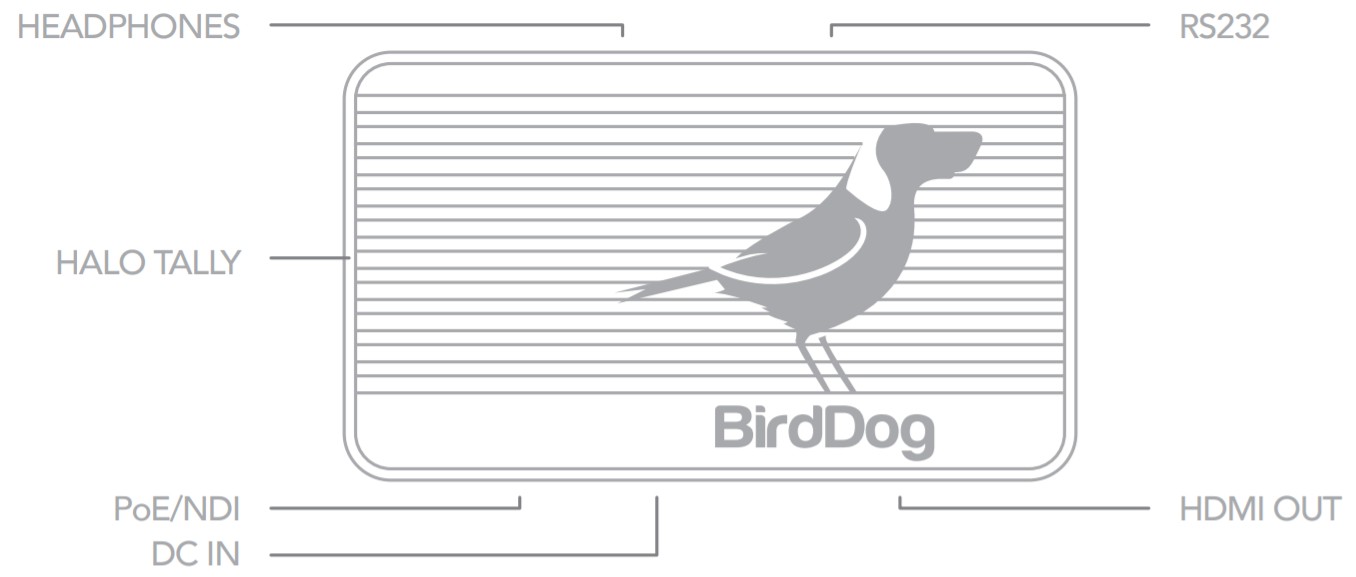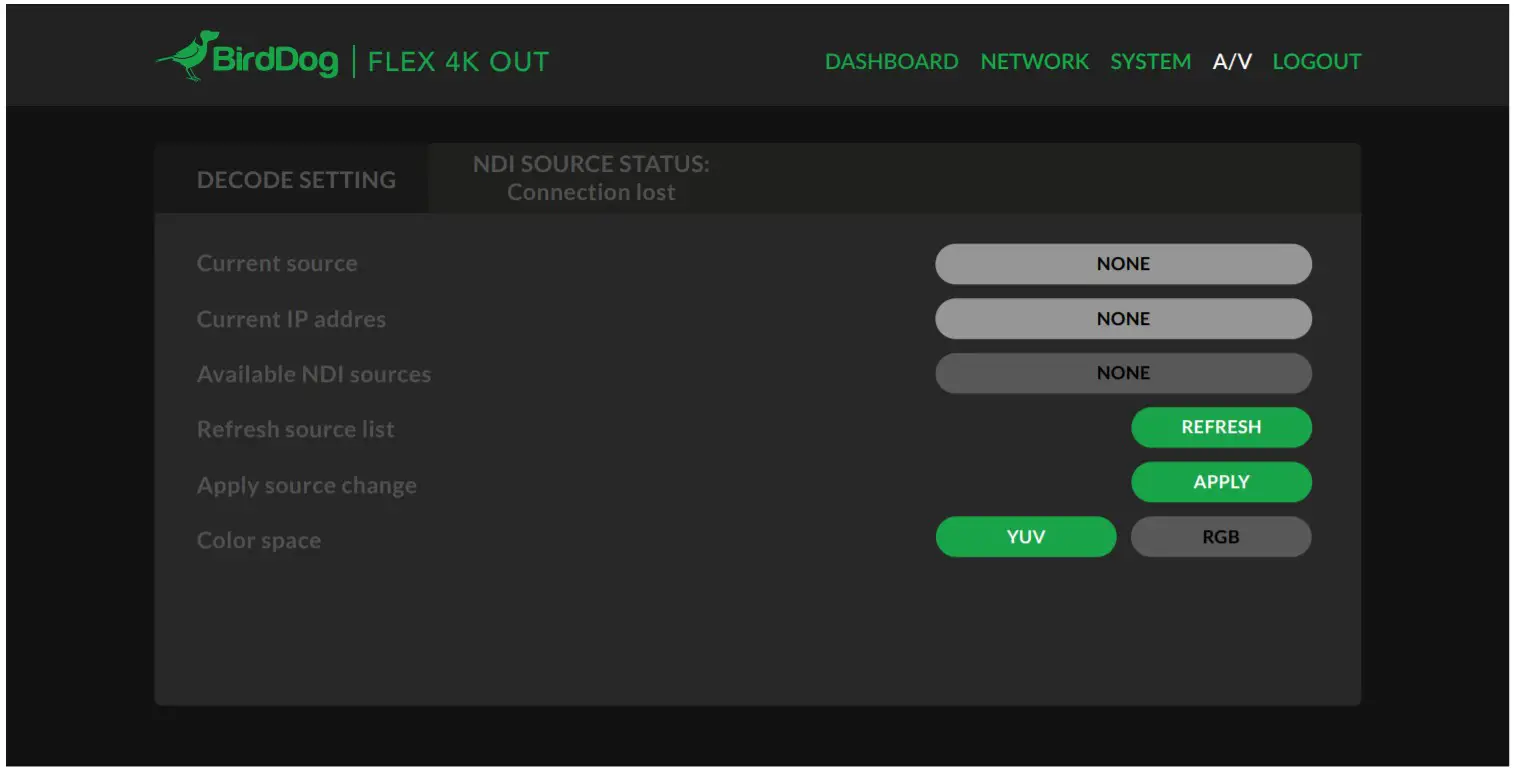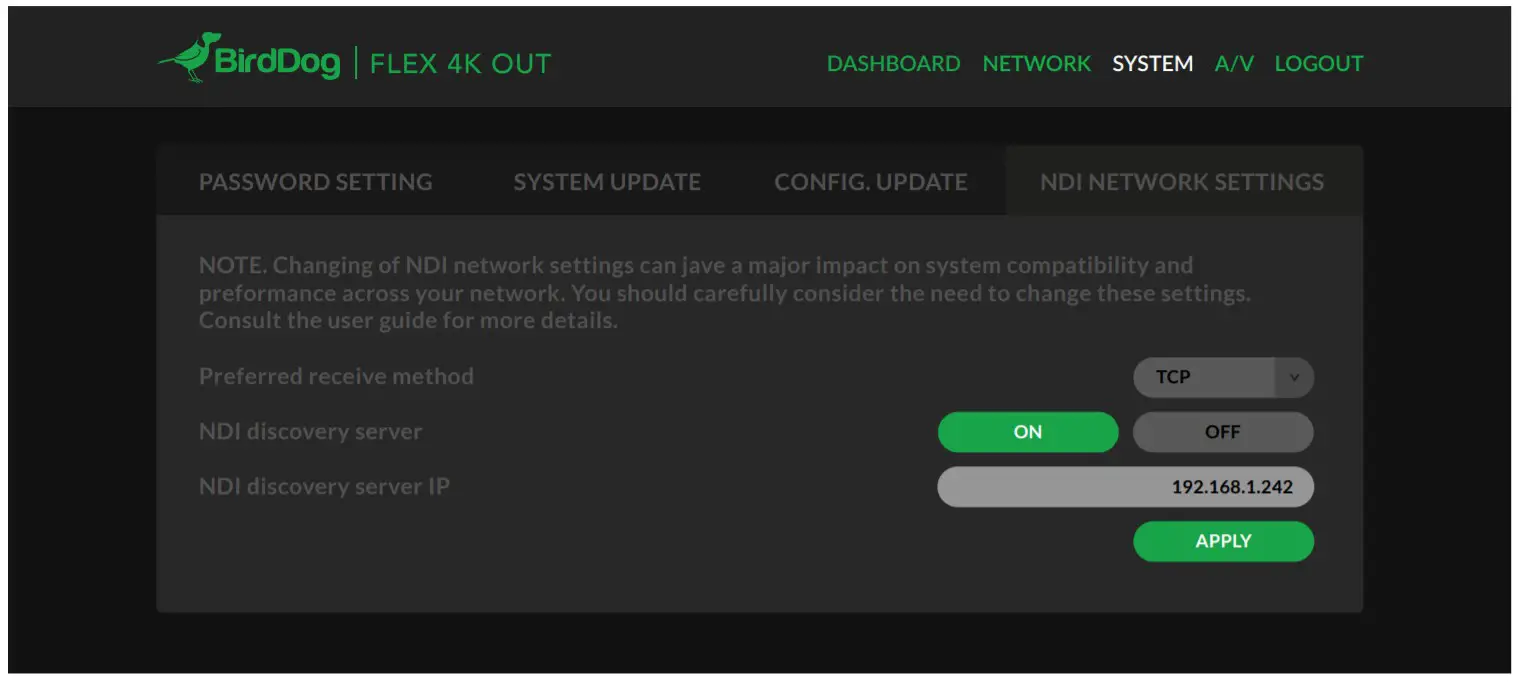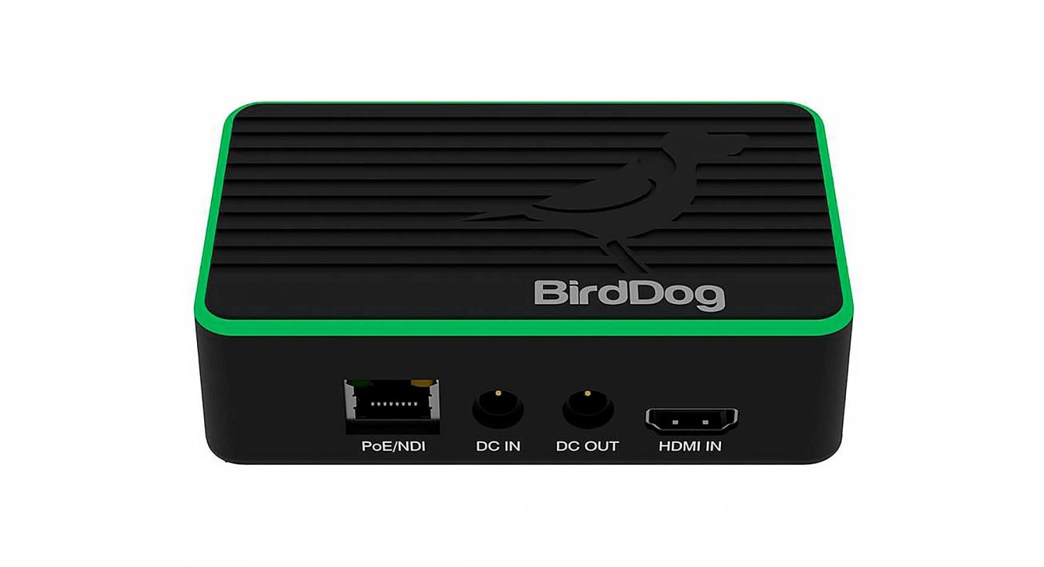 FLEX 4K OUTTHE SMALLEST 4K NDION THE PLANET
FLEX 4K OUTTHE SMALLEST 4K NDION THE PLANET


USER GUIDE | JAN 2021

GETTING TO KNOW YOUR DEVICE
Thanks for purchasing BirdDog Flex 4K Out Converter. Please take some time to read this document to allow you to get the most out of your purchase and familiarize yourself with the features available in the unit.Physical connectors


Powering your 4K ConverterThis converter is equipped with a sophisticated system allowing power from various sources:PoE+ (Power over Ethernet)PoE+ is a convenient way to power this converter as it allows both data and power to be sent through the same standard Ethernet cable. To take advantage of PoE+, the network switch that the converter is directly plugged into must support PoE+ (802.11at).Different network switches are capable of providing different amounts of total power to all connected devices. This Flex 4K converter uses approximately 14 watts in PoE+ mode to operate on its own, and up to 30w when powering additional equipment.DC INLocated at the side of the Flex 4K converter is a DC In connection port. This power input socket is capable of accepting 12vDC power. You should only power this device with the included AC adaptor.Thermal managementThis product has been engineered to be actively cooled. In order to achieve the best thermal performance, the fan assembly has been carefully designed to provide optimum cooling while remaining extremely quiet. It is normal for warm air to pass through the vent outlets. The main processor is capable of operating up to 100º C / 212º F.


BOOTING UP YOUR BIRDDOG DEVICE
Indication of the system boot processAs soon as the converter detects a power input the fan will begin to spin. After approximately 3 seconds the Halo Tally light will illuminate orange and you will notice the network activity indicator will begin to flash indicating that the device is now able to see the computer network. After a further 20 seconds, the Halo Tally will flash Green and Red indicating the unit is completely booted and ready for operation.


OPERATING YOUR CONVERTER
Web configuration panelIn this release, the web configuration panel allows you to alter key settings of your converter, specifically A/V settings, and video frame rates, restarting the video processing engine, changing networking parameters, and applying firmware updates.Access via a web browser (URL)To access the web configuration panel please point your computer web browser to: http://birddog-xxxxx.local/ “xxxxx” is the serial number of the converter, the serial number is printed on the box and on the main unit.Note the web address is case sensitive and should be all lower case.Your computer will need to have `Bonjour’ services loaded in order to access the unit via its `friendly’ name described above. Apple devices come pre-installed with Bonjour, while Windows devices need a small plugin available here: https://support.apple.com/kb/dl999?locale=en_AUAccessing via an IP addressYour converter is configured to automatically receive a network (IP) address from the computer network via DHCP (Dynamic Host Configuration Protocol). Most corporate, education and home networks have a DHCP server present on the network to allow this to occur. Usually, your Internet Router provides this. If your device receives an IP address automatically from this server (DHCP) the IP address can be discovered in several ways, including BirdDog Central Lite available from bird-dog.tv/firmware Accessing on a network without a DHCP serverSome standalone or private networks may not have a DHCP server. After 30 seconds of searching for an automatically assigned IP address, the device will fall back to a default address which is: 192.168.100.100In order to access the web configuration panel on a network that is configured to a different subnet, change your computer’s IP address to match the BirdDog unit’s IP address range. Once you gain access to the BirdDog web configuration panel choose your IP address to match the rest of the devices on your network.For instructions on setting your computer’s IP address please consult your computer operating system manual or IT support resources.
PASSWORD MANAGEMENT
Once you direct your web browser to the web configuration panel you will need to log in to change any settings.


Default passwordThe web configuration panel is secured by a user-selectable password. The default password is:Birddog (one word, lower case).To change the password simply log in using the default password, navigate to the network tab in the web interface, and select change password.It is recommended to change this password in a network environment where your device is shared with other users (e.g. not private). By entering this password, the user is granted full access to the configuration settings and could interrupt a live program.
A/V SETUP


Video ModeAll available sources are listed in the drop-down menu in the DECODE SETTINGS section of the web interface, select the desired source and press APPLY to begin receiving this source.You can switch between any available sources on the network by choosing them from the drop-down menu and pressing APPLY again.Note. If you are unable to successfully receive a source, please double-check that the video format and frame rate are ones that are supported by your unit.YUV Colour SpaceBuilt into BirdDog Flex is color space conversion, some NDI computer sources provide video in RGB or YUV color space. If you experience inverted colors on your computer-based source swap RGB for YUV color space.
NETWORK


Device namingWhen your device is first powered on it defaults to the naming convention as described in the web configuration panel section of this manual.It is possible to change the name along with the network settings to better suit your environment.Configuration methodYou can configure your device to operate on the network with a dynamic (DHCP) IP address or a fixed address. For smaller networks DHCP networking is generally suitable, however larger networks with managed operations will often determine each device needs to have a dedicated and static IP address.DHCP IP addressDHCP is set as the network configuration by default for Mini.Static IP addressTo enable a static IP address, change the configuration method to static and fill in the details required in Address, Mask, and Gateway. Particular attention should be paid to the Address and Mask fields as incorrect information entered will result in the device not being visible on the network and a factory reset will be required in order to recover the unit.IP address recoveryIn the event that the device is not visible on the network, the network has changed, or the static IP address details have been lost, reset the BirdDog back to its default settings by following the factory reset procedure.BirdDog nameYou can name each unit with a friendly name that makes sense for each production (Camera 1, Camera 2, etc). This name will appear on any NDI receiver when it looks for the video coming from Mini over the network. The name must not include any special characters and can be any combination of `a-z, 1-0, and `.Note: no uppercase characters are valid.On NDI receiving devices, the device will present as a source as follows:Birddog-name [HDMI] when the unit is set to automatic input.
SYSTEM
System updateThe converter is updateable via the web interface. Please check the below address regularly to ensure you have the latest firmware available for your device. Having the latest firmware ensures you have all the latest features and performance updates to get the most out of Flex 4K Converters:bird-dog.tv/firmware-updatesAfter downloading the latest firmware release, navigate to the settings tab on the web configuration console and click on Choose file… select the firmware update file and press the update button.
NDI NETWORK SETTINGS


Preferred Receive MethodTCPTCP is the default transmission method for NDI, it operates well within local networks with predictable latency and limited jitter. BirdDog recommends that TCP be used for typical applications, and only using alternative transports for specific reasons.UDPUDP is recommended for networks where there is extended latency from one end to the other. The nature of UDP means that it does not need to receive a confirmation of each packet being received successfully vastly improving performance on distance WANs. UDP can have some consequences f there are other issues on the network such as jitter or lost packets as it will not inherently re-sent a lost packet.MulticastMulticast is especially useful for use-cases that require a single source to be received on multiple receivers simultaneously.Utilizing Multicast offloads the distribution of the NDI A/V packets from the BirdDog Flex 4K to the network infrastructure. You should take care to ensure your network is specifically configured to support Multicast as using it on an ill-prepared network can create unintended network problems.MultiTCPMultiTCP is a new NDI transport method that allows users to send NDI video over poor network topography such as WAN (Wide Area Networks) without experiencing issues such as packet loss and lost frames. In the past in order to send NDI video over a WAN, UDP transport was the only option available. UDP solved some issues of WAN applications by allowing the NDI video to travel without dropping masses of frames but results in dropped packets being missed which could cause unstable video. UDP also places more performance demands on devices sending and receiving the signal.MultiTCP employs a new method of sending TCP packets whereby it opens a mass of TCP connections over the WAN and uses them in a round-robin manner, this allows each individual TCP connection enough time to acknowledge the receiving packet, confirm nothing is lost, and prepare for the next one before it’s sent the next TCP packet in the round-robin. This is similar to a RAID setup in traditional storage.
OPERATION
Factory resetting your unitIf you have lost any network settings or cannot find your BirdDog Flex device on the network, you can perform a network factory reset.Simply depress the reset button located next to the RS-232 port for 5 seconds until the Halo tally illuminates flashing red. The unit will be accessible as per factory settings approximately 10 seconds later.
References
[xyz-ips snippet=”download-snippet”]

